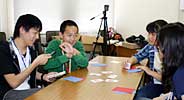Guarding against disasterWhat should be done to prepare for
a major earthquake?
a major earthquake?
What would happen if a major earthquake or tsunami hit the Hiroshima area? How should we prepare for such a possibility? The Great Eastern Japan Earthquake caused enormous damage along the eastern coast of the country. It wasn't a disaster that occurred far away from us.
According to research conducted by the Hiroshima Prefectural Office, the possibility exists that an earthquake with a magnitude of 7.0 could strike the prefecture at some point. Within the next 30 years, an earthquake in the sea to the southeast, with the epicenter off Aichi, as well as an earthquake in the sea to the south, with the epicenter off Shikoku, are predicted to occur. In these earthquakes, the maximum height for a tsunami would be 1.1 meters. Although the water would only reach waist-level, the force of the wave could swallow human beings right up.
The junior writers reflected on what should be done in the event of an emergency through a card game which simulates disasters. We also played another game for smaller children which teaches how to respond when a natural disaster strikes. In addition, we tried eating the kind of food that is distributed at emergency shelters. And we wrote messages of encouragement for people in the affected areas of eastern Japan.
An estimated 3,400 Hiroshima residents may die in a 7.0 earthquake
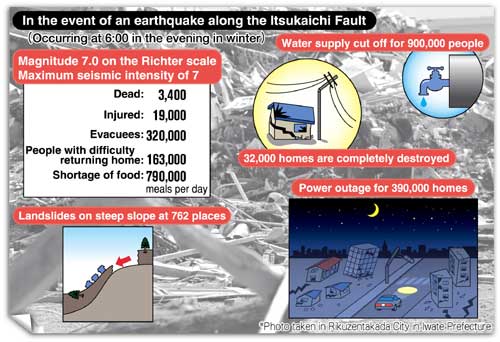
The Hiroshima Prefectural Office has compiled a report which predicts the extent of damage if an earthquake strikes. The report was begun in the wake of the Great Hanshin Earthquake in 1995 and was completed in March 2007. It makes assumptions in connection with earthquakes that are predicted to strike in the southern Pacific Ocean, with the epicenter offshore of Shikoku, and in the sea to the southeast, with the epicenter off Aichi Prefecture. The earthquake off Aichi Prefecture would be the result of active fault lines which extend from western Hiroshima Prefecture to eastern Yamaguchi Prefecture and could occur anywhere along these fault lines. The report by Hiroshima Prefecture estimates the damage that would affect human beings, buildings, and the economy.
The greatest destruction to human beings would be caused by an earthquake that occurred at 6:00 in the evening on a winter day along the 20 kilometer-long Itsukaichi Fault which stretches from Hatsukaichi to Asakita Ward in the city of Hiroshima. Such an earthquake could have a magnitude of 7.0 and 3,400 might lose their lives. In addition, 320,000 people would be forced to live in evacuation centers and 163,000 people would have to walk more than 10 kilometers to get home from their workplaces and schools. A total of 964 evacuation centers and medical facilities would not be able to function as usual.
As measures to guard against such a scenario, the report recommends strengthening buildings to make them earthquake-resistant, and making wise use of a "hazards map" which shows the projected damage caused by earthquakes and landslides as well as evacuation sites. (Minako Iwata, 17, and Kana Kumagai, 16)
|
Disaster simulation game "Crossroad" |
|
We played a card game called "Crossroad," a disaster simulation game that involves the players answering "yes" or "no" to situations that might occur in a time of disaster and exchanging views over these situations. Our instructor, Kunio Hayashi, 50, of the Kure City Fire Department, told us, "There are no right answers. The important thing, through simulating an earthquake in this way, is to consider what you should do in the event of an emergency and think about the people who are suffering in disaster-hit areas." |
|
Q: You are the captain of your school's baseball team. A powerful earthquake with a magnitude of 6.0 has struck. A big tsunami is likely to hit in about 40 minutes. Your team has all evacuated and reached higher ground. But now you can't find the girl who serves as an assistant for the team and her mother and grandmother. Will you return to look for them?
 |
Five people answered "yes" (they would return), while ten people said "no" (they wouldn't return). Reasons for choosing "yes" included: "I would probably have some idea where they were" and "If I'm a baseball player, I would probably be a fast runner and I could return quickly." On the other hand, the people that said "no" gave such reasons as "They might have already run away to another place," "It would be hard to find them in such a short time," and "We might pass by each other without even noticing." (Masataka Tanaka, 16) |
|
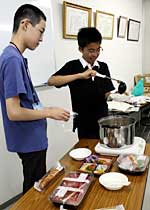 Junior writers dish "Zosui," made by combining meals, into paper bowls. |
Q: You are the leader at an evacuation center where 150 people are staying. The meal distribution has been delayed and 60 meals arrived today, but they are past the expiration date of the day before. What will you do?
Resolving the problem by making rice porridge
The participants in the game, the junior writers and others, first wrote down their ideas on slips of paper. Ideas included: "Distribute one meal per family"; "First distribute them to pregnant women, children, the elderly, and the disabled"; and "Divide each meal in two to produce 120 meals." Some people, though, responded that they wouldn't distribute the meals at all. In fact, in the wake of the Great Hanshin Earthquake, such a scenario actually occurred and the meals weren't distributed due to the principle of fairness on the part of the government.
One way of resolving the problem is to put the meal ingredients together to make a rice porridge dish called "Zosui" that contains vegetables, meat, and fish. We tried making this dish by combining five meals. The hunger of all 17 participants in the game was satisfied by this magical dish.
"Zosui" is easy to cook. You pour water into a big pot with "Zosui" broth and the contents of the meals, then simmer it for a while. Instead of the "Zosui" broth, you can also use an instant consomm? soup stock. Before putting them into the pot, you should remove the breading on the tempura and slice the egg, fish, and vegetables.
We put plastic wrap inside our paper bowls so we wouldn't need to wash them afterwards. The taste of our "Zosui" was better than we expected and we all enjoyed it. (Yusuke Suemoto, 14)
|
Q: You are a student who is studying for an entrance examination. But you're staying at an evacuation center and you're supposed to help out there with a number of things. Because of this, you're afraid that you may fail the exam. Do you devote all your time to studying and back out of helping with the work at the evacuation center?
 |
Three of the participants answered "yes" (I would devote myself to studying) while 12 people said "no" (I wouldn't just study). Reasons for responding "yes" included: "If I passed the exam, my good news would help cheer people up at the evacuation center." and "If I failed the exam and I had to study another year for it, it would cost a lot of money." And reasons for saying "no" included: "Devoting yourself to studying would mean that you aren't thinking of the feelings of the people around you" and "Short periods of time, like at lunch or at night, could be made use of for studying." (Masaya Obayashi, 14) |
|
Q: You are a member of a family whose home was partially destroyed in a major earthquake and you have arrived at an evacuation center. Your family has emergency provisions containing food and water that will last for three days. However, you see many other families who don't have any food or water. Should you open your emergency provisions?
 |
Eight participants answered "yes" (I would open it) and seven said "no" (I wouldn't open it). The people who answered "yes" gave such reasons as "If others don't have emergency provisions, that's their own fault. If I have some, it's natural to open them and use them" and "We should share our provisions with others." Those responding "no" said "Until we learn when the emergency supplies will arrive, we shouldn't open our own provisions" and "Even if I opened them, I would eat the food in secret." (Masataka Tanaka, 16) |
|
Q: You are a staff member in charge of emergency relief supplies. Would you burn the extra second-hand clothes that you have received?
 |
Eight people said "yes" (I would burn them) while four people said "no" (I wouldn't burn them). Some of the "yes" reasons included: "More relief supplies will be expected" and "If it costs money to store them, that would be wasteful." Reasons for saying "no" included: "We can spread them out on the floors of the evacuation center" and "We can recycle them and use the cloth." The reality is that distributing second-hand clothing is a difficult task, and because of the change of seasons, a lot of old clothes finally pile up. I was impressed by Mr. Hayashi's idea when he said we could sell the second-hand clothes, like at a flea market, and donate the profits to support people in the disaster-hit areas. (Masaya Obayashi, 14) |
Mimicking pictures to learn about responding to disasters
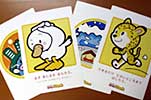
We played another card game called "Bousai Duck," which helps small children learn about responding to disasters. The game enables children to learn by moving their body or speaking.
The cards are 36.5 centimeters long and 25.7 centimeters wide, and show 12 kinds of pictures, with images on both sides of the cards. On the front of the cards are pictures of disasters like fires and earthquakes and when the children are shown a card, they have to mimic the pose on the back side of the card. These poses include such things as a duck curling itself up and a raccoon dog covering its mouth with a handkerchief. In English, "duck" also has the meaning of "lowering oneself quickly to avoid something." When the "earthquake" card was shown, I got flustered and I stood there without knowing what to do. It was hard to react quickly. (Arisa Shiromoto, 15) |
Real difficulties suffered by people in the Great Hanshin Earthquake lead to a resource for learning about disasters
Katsuya Yamori, a professor in the Disaster Prevention Research Institute of Kyoto University, developed the game "Crossroad"
 Katsuya Yamori, 48, a professor in the Disaster Prevention Research Institute of Kyoto University, led the effort to develop the game "Crossroad." The game was produced as part of a project to research and learn from the Great Hanshin Earthquake. The project took place in 2005, ten years after the earthquake struck. Professor Yamori explained: "By playing the game, people are encouraged to consider and discuss natural disasters from a personal perspective." The fruits of the game can be seen following the powerful earthquake which recently struck eastern Japan. Mr. Yamori received an email from someone who lives in the city of Sendai. The person told him that a previous experience of playing the game became helpful in dealing with real problems at an evacuation center, such as sharing food. Mr. Yamori has thought of a new and difficult question: "Would you go do volunteer work in an area near a nuclear power plant when there is the possible risk of radiation exposure?" He's now pondering a new "Crossroad" game about the Great Eastern Japan Earthquake that will feature new troubles or problems. (Arisa Shiromoto, 15) |
|
Ideas to help prepare for a natural disaster |
|
Based on the coverage we undertook for this issue, we would like to share our ideas for preparing for natural disasters in our daily lives.
Hold fire drills and evacuation drills in the community
We would like to see evacuation drills in which all the schools in the community would take part. The schools would practice moving quickly, by class, to the local evacuation center. It would be good, too, to conduct such a drill without warning. Prior to this drill, though, we should practice such things as "in the event of a fire, keep low to the ground when evacuating" and "in the event of a tsunami, run away quickly."
Place shoes and a flashlight beside your bed
Imagine that an earthquake strikes while you are sleeping. In such a scenario, it would be good to have shoes and a flashlight beside your futon mattress or under your bed. If there is a power outage, it could be difficult moving around in the dark and walking through the house with things that have fallen and broken on the floor might be dangerous.
Promote the distribution of food and clothing
It sometimes happens that emergency supplies of food and clothing to disaster-stricken areas aren't really the sort of items that are needed. Therefore, it might be a good idea to ask the business community to create a system in which they would provide a certain amount of new goods each season. Then, if a disaster strikes, we would donate money to those businesses instead of us sending goods directly to evacuation centers.
Walk the neighborhood to know it well
It's a good idea to walk around your neighborhood on a normal day. In this way, you can confirm where things are, such as the evacuation center, convenience stores, manholes, public telephones, and fire extinguishers. This knowledge could be useful in case of an emergency.
Making a banner to lend support to people in the disaster zone
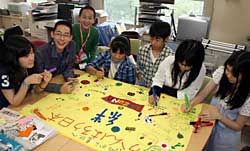 Thinking of the children in the disaster zone, junior writers write messages of encouragement on the banner. |
We made a large banner with messages of encouragement for the children who are suffering because of the earthquake and tsunami. The messages include things like "Keep your chin up, Japan" and "Hiroshima is with you." We plan to ask Kunio Hayashi of the Kure City Fire Department to deliver it to the disaster-hit area.
The banner is yellow and it's 84 centimeters long and 115 centimeters wide. In the middle is a piece of felt with the word "kizuna," which means "bonds." We drew pictures of flowers and smiling faces around it. The flag expresses our feelings of "Although we can't come see you in person, we want to reach out to you" and "We want to convey our energy and our smiles to you."
If your group or school would like to join our effort to send banners and fans with messages of encouragement to people in eastern Japan, please contact Peace Seeds at 082-236-2714. (Mizuki Yata, 16, served as a writer and photographer)
